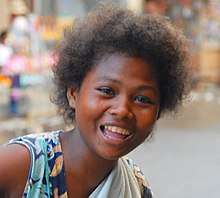Negrito
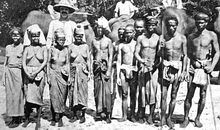 | |
| Regions with significant populations | |
|---|---|
|
(Andaman and Nicobar Islands) (Peninsular Malaysia) (Luzon, Palawan, Panay, Negros, and Mindanao) (Southern Thailand) | |
| Languages | |
| Andamanese languages, Aslian languages, Nicobarese languages, Philippine Negrito languages | |
| Religion | |
| Animism, ethnic religions |
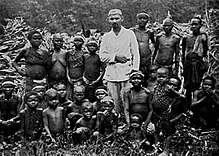
The Negrito (/nɪˈɡriːtoʊ/) are several different ethnic groups who inhabit isolated parts of South and Southeast Asia.[1] Their current populations include the Andamanese peoples of the Andaman and Nicobar Islands, the Semang and Batek people of Peninsular Malaysia, the Maniq people of Southern Thailand, and the Aeta people, Ati people, and 30 other ethnic groups in the Philippines.
Etymology
The word "Negrito" is the Spanish diminutive of negro, used to mean "little black person". This usage was coined by 16th-century Spanish missionaries operating in the Philippines, and was borrowed by other European travellers and colonialists across Austronesia to label various peoples perceived as sharing relatively small physical stature and dark skin.[2] Contemporary usage of an alternative Spanish epithet, Negrillos, also tended to bundle these peoples with the pygmy peoples of Central Africa, based on perceived similarities in stature and complexion.[2] (Historically, the label Negrito has occasionally been used also to refer to African pygmies.)[3] The appropriateness of using the label "Negrito" to bundle together peoples of different ethnicities based on similarities in stature and complexion has been challenged.[2]
.jpg)
Many on-line dictionaries give the plural in English as either "negritos" or "negritoes", without preference. The plural in Spanish is "negritos".[4][5]
Origins
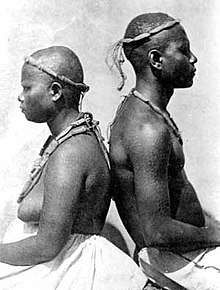
Genetics
The Y-chromosome Haplogroup C-M130, as seen, for example, in the Semang of Malaysia, and Haplogroup D-M174 among Andaman Islanders, are more prominent among Negritos than the general populations surrounding them.[6] Haplogroup O-P31 is also common among Austroasiatic-speaking Negrito peoples, such as the Maniq and the Semang.
.jpg)
Aeta men are of great interest to genetic, anthropological and historical researchers because at least 83% of them belong to haplogroup K2b, in the form of its rare primary clades K2b1* and P* (a.k.a. K2b2* or P-P295*).[7] Most Aeta males (60%) carry K-P397 (K2b1), which is otherwise uncommon in the Philippines and is strongly associated with the indigenous peoples of Melanesia and Micronesia. Basal P* is rare outside the Aeta and some other groups within Maritime Southeast Asia.
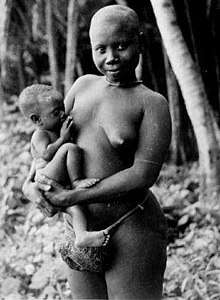
Genetic research has shown that the Negritos have existed as a separate group for a long time, comparable to the Australoid and Southwest Pacific groups. This has often been interpreted to the effect that they are remnants of the original expansion from Africa some 70 thousand years ago. Studies in osteology, cranial shape and dental morphology have connected the Semang to Australoid populations, while conecting the Andamanese to Africans in craniometry and to South Asians in dental morphology, and Philippine negritos to Mongoloid Southeast Asians. A possible conclusion of this is that the dispersal of mitochondrial haplogroup B4a1a is connected to the distinction between Philippine and other negritos.[8] However, another study suggests that the Onge (indigenous to Little Andaman) are "more closely related to Southeast Asians than they are to present-day South Asians", and that the Great Andamanese "appear to have received a degree of relatively recent admixture from adjacent regional populations but also share a significant degree of genetic ancestry with Malaysian negrito groups".[9]
Bulbeck (2013) likewise noted that the Andamanese's nuclear DNA clusters with that of other Andamanese Islanders, as they carry Haplogroup D-M174 and maternal mitochondrial Haplogroup M unique to their own.[8] However, this is a subclade of the D haplogroup which has not been seen outside of the Andamans, a fact that underscores the insularity of these tribes.[10] Analysis of mtDNA, which is inherited exclusively by maternal descent, confirms the above results. All Onge belong to M32 mtDNA, a subgroup of M, which is unique to Onge people.[11] Their parental Y-DNA is exclusively Haplogroup D, which is also only found in Asia.[12]
A 2010 study by the Anthropological Survey of India and the Texas Biomedical Research Institute identified seven genomes from 26 isolated "relic tribes" from the Indian mainland, such as the Baiga tribe, which share "two synonymous polymorphisms with the M42 haplogroup, which is specific to Australian Aborigines". These were specific mtDNA mutations that are shared exclusively by Australian aborigines and these Indian tribes, and no other known human groupings.[13]
A study of human blood group systems and proteins in the 1950s suggested that the Andamanese peoples were more closely related to Oceanic peoples than African pygmy peoples. Genetic studies on Philippine Negritos, based on polymorphic blood enzymes and antigens, showed that they were similar to their surrounding populations.[14]
Negrito peoples may descend from Australoid-Melanesian settlers of Austronesia. Despite being isolated, the different peoples do share genetic similarities with their neighboring populations.[14][15] They also show relevant phenotypic (anatomic) variations which require explanation.[15]
In contrast, a recent genetic study found that unlike other early groups in Malesia, Andamanese Negritos lack Denisovan hominin admixture in their DNA. Denisovan ancestry is found among indigenous Melanesian and Aboriginal Australian populations between 4–6%.[16][17]
Some studies have suggested that each group should be considered separately, as the genetic evidence refutes the notion of a specific shared ancestry between the "Negrito" groups of the Andaman Islands, the Malay Peninsula, and the Philippines.[18] Indeed, this sentiment is echoed in a more recent work from 2013 which concludes that "at the current level of genetic resolution ... there is no evidence of a single ancestral population for the different groups traditionally defined as 'negritos'."[9]
Anthropology
A number of features would seem to suggest a common origin for the Negrito and Negrillo, including short stature, dark skin, scant body hair, and occasional steatopygia. The claim that the Andamanese more closely resemble African pygmies than other Austronesian populations in their cranial morphology in a study of 1973 added some weight to this theory, before genetic studies pointed to a closer relationship with their neighbours.[14]
Multiple studies also show that Negritos from Southeast Asia to New Guinea share a closer cranial affinity with Australo-Melanesians.[19][20]
Historical distribution
Andamanese Negrito people
According to both Wells and Mason, the Australoid Negritos, similar to the Andamanese adivasis of today, were the first identifiable human population to colonize India, likely 30–65 thousand years before present (kybp).[21][22] This first colonization of the Indian mainland and the Andaman Islands by humans is theorized to be part of a great coastal migration of humans from Africa along the coastal regions of the Indian mainland and towards Southeast Asia and Oceania.[21]
The Negrito peoples may be descended from ancient Australoid-Melanesian settlers of Austronesia, or represent an early split-off from the earliest Africans who dispersed out of Africa along this southern coastal route.
Other populations
Negritos may have also lived in Formosa (Taiwan).[23] The Negrito population shrank to the point that, up to 100 years ago, only one small group lived near the Saisiyat tribe.[23] Evidence of their former habitation is a Saisiyat festival celebrating the black people in a festival called Pas-ta'ai.[23]
See also
Notes
- ↑ Snow, Philip. The Star Raft: China's Encounter With Africa. Cornell Univ. Press, 1989 ( ISBN 0801495830)
- 1 2 3 Manickham, Sandra Khor (2009). "Africans in Asia: The Discourse of 'Negritos' in Early Nineteenth-century Southeast Asia". In Hägerdal, Hans. Responding to the West: Essays on Colonial Domination and Asian Agency. Amsterdam University Press. pp. 69–79. ISBN 978-90-8964-093-2.
- ↑ See, for example: Encyclopædia Britannica Eleventh Edition, 1910–1911: "Second are the large Negrito family, represented in Africa by the dwarf-races of the equatorial forests, the Akkas, Batwas, Wochuas and others..." (p. 851)
- ↑ "Merriam Webster".
- ↑ "The Free Dictionary".
- ↑ 走向遠東的兩個現代人種 Archived 7 October 2009 at the Wayback Machine.
- ↑ ISOGG, 2016, Y-DNA Haplogroup P and its Subclades – 2016 (20 June 2016).
- 1 2 Bulbeck, David (November 2013). "Craniodental Affinities of Southeast Asia's "Negritos" and the Concordance with Their Genetic Affinities". Human Biology. 85 (1): 95–134. doi:10.3378/027.085.0305. PMID 24297222. Retrieved 17 December 2013.
- 1 2 Chaubey, Gyaneshwer; Endicott, Phillip (2013-02-01). "The Andaman Islanders in a regional genetic context: reexamining the evidence for an early peopling of the archipelago from South Asia". Human Biology. 85 (1–3): 153–172. doi:10.3378/027.085.0307. ISSN 1534-6617. PMID 24297224.
- ↑ Kumarasamy Thangaraj, Lalji Singh, Alla G. Reddy, V. Raghavendra Rao, Subhash C. Sehgal, Peter A. Underhill, Melanie Pierson, Ian G. Frame, and Erika Hagelberg (2002), Genetic Affinities of the Andaman Islanders, a Vanishing Human Population (PDF), archived from the original (PDF) on 29 October 2008, retrieved 16 November 2008,
Our data indicate that the Andamanese have closer affinities to Asian than to African populations and suggest that they are the descendants of the early Palaeolithic colonizers of Southeast Asia ... All Onge and Jarawa had the same binary haplotype D ... Great Andaman males had five different binary haplotypes, found previously in Southeast Asia, the Indian subcontinent, and Melanesia
- ↑ M. Phillip Endicott; Thomas P. Gilbert; Chris Stringer; Carles Lalueza-Fox; Eske Willerslev; Anders J. Hansen; Alan Cooper (2003), "The Genetic Origins of the Andaman Islanders" (PDF), American Journal of Human Genetics, 72 (1): 178–184, doi:10.1086/345487, PMC 378623, PMID 12478481, retrieved 2009-04-21
- ↑ Reich, David; Kumarasamy Thangaraj; Nick Patterson; Alkes L. Price; Lalji Singh (24 September 2009). "Reconstructing Indian Population History". Nature. 461 (7263): 489–494. doi:10.1038/nature08365. PMC 2842210. PMID 19779445.
- ↑ Satish Kumar; Rajasekhara Reddy Ravuri; Padmaja Koneru; BP Urade; BN Sarkar; A Chandrasekar; VR Rao (22 July 2009), "Reconstructing Indian-Australian phylogenetic link", BMC Evolutionary Biology, BioMed Central, 9: 173, doi:10.1186/1471-2148-9-173, PMC 2720955, PMID 19624810,
In our completely sequenced 966-mitochondrial genomes from 26 relic tribes of India, we have identified seven genomes, which share two synonymous polymorphisms with the M42 haplogroup, which is specific to Australian Aborigines…direct genetic evidence of an early colonization of Australia through south Asia
- 1 2 3 Thangaraj, Kumarasamy; et al. (21 January 2003), "Genetic Affinities of the Andaman Islanders, a Vanishing Human Population" (PDF), Current Biology, 13 (2): 86–93, doi:10.1016/S0960-9822(02)01336-2, PMID 12546781, archived from the original (PDF) on 29 October 2008
- 1 2 Stock, JT (2013). "The skeletal phenotype of "negritos" from the Andaman Islands and Philippines relative to global variation among hunter-gatherers". Human Biology. 85 (1–3): 67–94. doi:10.3378/027.085.0304. PMID 24297221.
- ↑ Reich; et al. (2011). "Denisova Admixture and the First Modern Human Dispersals into Southeast Asia and Oceania". The American Journal of Human Genetics. 89: 516–528. doi:10.1016/j.ajhg.2011.09.005. PMC 3188841. PMID 21944045.
- ↑ "Oldest human DNA found in Spain – Elizabeth Landau's interview of Svante Paabo". CNN. 2013-12-09.
About 3% to 5% of the DNA of people from Melanesia (islands in the southwest Pacific Ocean), Australia and New Guinea as well as aboriginal people from the Philippines comes from the Denisovans.
- ↑ Catherine Hill; Pedro Soares; Maru Mormina; Vincent Macaulay; William Meehan; James Blackburn; Douglas Clarke; Joseph Maripa Raja; Patimah Ismail; David Bulbeck; Stephen Oppenheimer; Martin Richards (2006), "Phylogeography and Ethnogenesis of Aboriginal Southeast Asians" (PDF), Molecular Biology and Evolution, Oxford University Press, 23: 2480–91, doi:10.1093/molbev/msl124, PMID 16982817, archived from the original (PDF) on 9 April 2008
- ↑ William Howells (1993). Getting Here: The Story of Human Evolution. Compass Press.
- ↑ David Bulbeck; Pathmanathan Raghavan; Daniel Rayner (2006), "Races of Homo sapiens: if not in the southwest Pacific, then nowhere", World Archaeology, Taylor & Francis, 38 (1): 109–132, doi:10.1080/00438240600564987, ISSN 0043-8243, JSTOR 40023598
- 1 2 Spencer Wells (2002), The Journey of Man: A Genetic Odyssey, Princeton University Press, ISBN 0-691-11532-X,
…the population of south-east Asia prior to 6000 years ago was composed largely of groups of hunter-gatherers very similar to modern Negritos… So, both the Y-chromosome and the mtDNA paint a clear picture of a coastal leap from Africa to south-east Asia, and onward to Australia… DNA has given us a glimpse of the voyage, which almost certainly followed a coastal route via India
- ↑ Jim Mason (2005), An Unnatural Order: The Roots of Our Destruction of Nature, Lantern Books, ISBN 1-59056-081-7,
Australia's 'aboriginal' peoples are another case in point. At the end of the Ice Age, their homeland stretched from the middle of India eastward into southeast Asia and as far south as Indonesia and nearby islands. As agriculture spread from its centers in southeast Asia, these pre-Australoid forager people moved farther southward to New Guinea and Australia.
- 1 2 3 Jules Quartly (27 Nov 2004). "In honor of the Little Black People". Taipei Times. p. 16. Retrieved 22 May 2011.

Further reading
- Evans, Ivor Hugh Norman. The Negritos of Malaya. Cambridge [Eng.]: University Press, 1937.
- Benjamin, Geoffrey. 2013. ‘Why have the Peninsular “Negritos” remained distinct?’ Human Biology 85: 445–484. [ISSN 0018-7143 (print), 1534-6617 (online)]
- Garvan, John M., and Hermann Hochegger. The Negritos of the Philippines. Wiener Beitrage zur Kulturgeschichte und Linguistik, Bd. 14. Horn: F. Berger, 1964.
- Hurst Gallery. Art of the Negritos. Cambridge, Massachusetts: Hurst Gallery, 1987.
- Khadizan bin Abdullah, and Abdul Razak Yaacob. Pasir Lenggi, a Bateq Negrito Resettlement Area in Ulu Kelantan. Pulau Pinang: Social Anthropology Section, School of Comparative Social Sciences, Universití Sains Malaysia, 1974.
- Mirante, Edith (2014). The Wind in the Bamboo: Journeys in Search of Asia's 'Negrito' Indigenous Peoples. Bangkok, Orchid Press.
- Schebesta, P., & Schütze, F. (1970). The Negritos of Asia. Human relations area files, 1-2. New Haven, Conn: Human Relations Area Files.
- Armando Marques Guedes (1996). Egalitarian Rituals. Rites of the Atta hunter-gatherers of Kalinga-Apayao, Philippines, Social and Human Sciences Faculty, Universidade Nova de Lisboa.
- Zell, Reg. About the Negritos: A Bibliography. edition blurb, 2011.
- Zell, Reg. Negritos of the Philippines. The People of the Bamboo - Age - A Socio-Ecological Model. edition blurb, 2011.
- Zell, Reg, John M. Garvan. An Investigation: On the Negritos of Tayabas. edition blurb, 2011.
External links
| Wikimedia Commons has media related to Negrito. |
| Wikisource has the text of the 1879 American Cyclopædia article Negritos. |
- Negritos of Zambales—detailed book written by an American at the turn of the previous century holistically describing the Negrito culture
- Andaman.org: The Negrito of Thailand
- Historycooperative.org: Africans and Asians: Historiography and the Long View of Global Interaction
- The Southeast Asian Negrito
